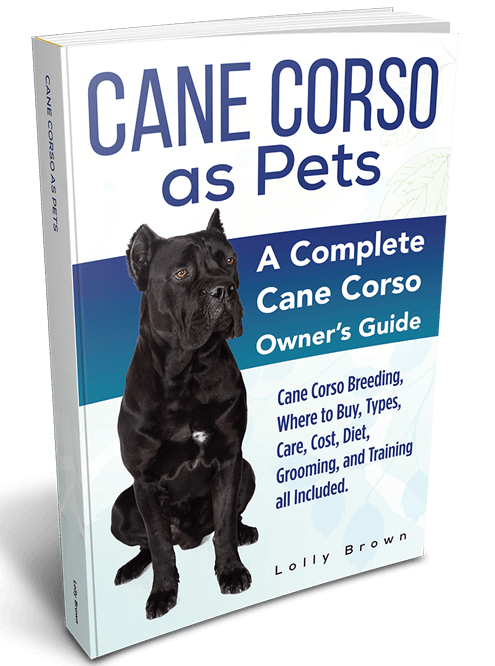CHAPTERS
Navigate to chapter
► Chapter 1: Cane Corso in Focus
Chapter 1: Cane Corso in Focus

Cane Corsos may often time look like your nosey neighbor, your overprotective parent, your loyal friend or that very affectionate lover you always wanted. In whatever attitude or mood it appeals, you can expect it to be well-mannered, protective, smart, serious, and a caring devoted pet you’ve always dreamed of.
The Cane Corso is a unique and quite an extraordinary breed of dog but it may not be the right choice for everyone. Before you decide whether or not it might be the right pet for you and your family, you need to learn and invest a significant amount of time in getting to know these animals.
In this chapter you will receive an introduction to the Cane Corso breed including some basic facts and information as well as the history of how it came about. This information, in combination with the practical information about keeping Cane Corso dogs in the next chapter, will help you decide if this is the perfect cat companion for you.
Facts About Cane Corsos
Cane Corsos are huge muscular dogs with a height proportionate to their large bodies. These dogs are believed as the descendants of Roman War Dogs and also one of many Mastiffs dog breed.
These dogs have large heads, with muzzles and skull that are not parallel but slightly convergent. Cane Corsos usually have black, medium- sized, almond-shaped eyes that are not round or bulging with medium-sized, triangular ears that maybe cropped or uncropped. Cane Corsos have a short flat coat, these dogs can are acceptable for dog shows. The most common colors for the Cane Corso breed include Black, Red, Grey, Fawn, Black Brindle, Chestnut Brindle, Gray Brindles with Black Mask, Gray Mask markings.
The Cane Corso was originally developed as a working breed which may not come as a surprise because of their large bodies. Cane Corsos are built to protect and serve as a watchdog, and they also have a reputation for having a “vigorous temperament.” The Cane Corso is a very intelligent dog and highly trainable breed, this Italian Mastiff is the quickest, most athletic and agile breed compare to other Mastiff – type dogs. Cane Corsos are very loyal and only trust people with whom they form very strong bonds with.
Cane Corsos often described as a “coursing mastiff” are serious by nature, though they can be a little bit witty around strangers. Proper socialization and training from a young age will help prevent the Cane Corso from being suspicious of new people. Cane Corsos do very well as family pets and they can also be good with children.
This breed needs and loves a firm and consistent training; they like to serve as peerless protectors to their owner which also means that they are not ideal as first pets because it requires an owner who is confident and strong-willed. Cane Corsos have a tendency to have unstable, aggressive temperaments which can be dangerous to innocent strangers, that’s why socialization and training at an early age is highly recommended.
The Cane Corso stands about 23 to 27 inches tall at maturity and there is only a slight difference in size between males and females of the breed. These dogs weigh between 90 and 120 pounds on average. Since the Cane Corso is a very big dog, it has a great deal of energy and needs a lot of daily exercise to work off that energy. With sufficient exercise, the Cane Corso can be adaptable and they are generally calm indoors as long as they get enough mental and physical stimulation during the day.
The average lifespan for the Cane Corso is between 10 and 12 years and the breed is very healthy in general. Like many small dogs, however, the Cane Corso is prone to health issues such as hip dysplasia and bloat. In terms of grooming, the Cane Corso is very low-maintenance. These dogs don’t shed too much because they have short coats and a soft brush will be sufficient.
Quick Facts
Pedigree: Italian Mastiff, descendants of Roman war dogs
AKC Group: Working Group
Breed Size: Large
Height: Female: 23.5 to 26 inches (58–66 cm); Male: 25 to 27.5 inches (62–70 cm)
Weight: 90 to 120 pounds
Coat Length: short flat coat
Coat Texture: little or no undercoat
Color: Black, Red, Grey, Fawn, Black Brindle, Chestnut Brindle, Gray Brindles
Markings: Black Mask, Gray Mask
Ears: cropped or uncropped; medium, triangular in shape
Tail: thick, supple
Temperament: loyal, well – mannered, agile, active, athletic
Strangers: may be wary around strangers
Other Dogs: generally good with other dogs if properly trained and socialized
Other Pets: friendly with other pets but if not properly introduce may result to potential aggression
Training: intelligent and very trainable
Exercise Needs: very active; daily walk recommended; breed is likely to develop problem behaviors without adequate mental/physical stimulation
Health Conditions: generally healthy but are usually prone to hip dysplasia and bloat
Lifespan: average 10 to 12 years
Cane Corso Breed History
Cane Corso is a Mastiff type of dog which was developed in Italy in the 19th century and is relatively the same with its cousin, the Neopolitan Mastiff breed. These dogs had been around since the Roman period and were originally used for warfare; their ancestral breed is called Canis Pugnax. Canis is a latin word for dog and Corso is derived from an Italian word which means sturdy or robust.
Continue Reading…
Want to read the entire thing?


